How fire took the Filene Center and the people put it back
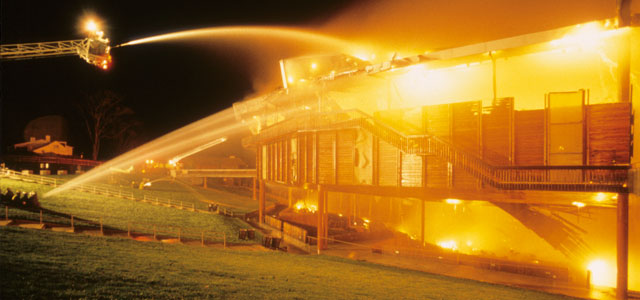
On the morning of April 5, 1982, Wolf Trap founder Catherine Filene Shouse received a call from President Ronald Reagan. Having learned that Wolf Trap’s Filene Center had burned to the ground overnight, he called immediately to offer support.
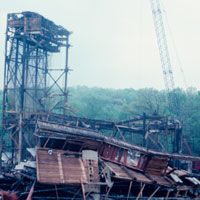
On the previous night, the Filene Center had indeed caught on fire—its roof buckling and twisting like tinfoil, its towering cedar beams cracking apart, sending thousands of pounds of sound and lighting equipment crashing to the ground, burying orchestra seats in rubble. Amidst the chaos, Mrs. Shouse talked about the future. She stood on the plaza, just yards from the tangle of giant hoses and firefighters trying in vain to douse the flames, and asked gathering staff how to maintain the launch date for the 1982 summer season. The season was just 6 weeks away.
At the same time, Mrs. Shouse also resolved to rebuild the Filene Center and preserve Wolf Trap’s commitment to being, as President Reagan put it, “a park for all people…one that enriches the cultural life of our nation.”
In the following days, months, and years, the outpouring of support from Wolf Trap’s patrons proved that they did, in fact, believe it to be their park.
In 2014, we acknowledged the 30th anniversary of the Filene Center reopening, as well as the extraordinary effort it took our community to make this possible.
From presidents to kids, the support comes in
President Reagan was not the only dignitary who called Mrs. Shouse the day after the fire. Former Presidents Nixon and Carter phoned to offer support. Virginia Governor Charles Robb and Congressman Frank Wolf toured the still-smoldering rubble to assess damage and discuss how to restore one of the nation’s cultural treasures.
A Presidential Task Force was quickly assembled to launch a plan to rebuild the Filene Center. It included representatives from the Department of the Interior, the National Endowment for the Arts, the National Park Service, and Reagan’s own staff, who worked with Wolf Trap’s private individual and corporate donors, board, and staff.
In addition to the government response, every sector of the Wolf Trap community offered support. Corporations made large grants and donated equipment. Loyal patrons held bakes sales, yard sales, dance-a-thons, swim-a-thons, marathons, and art auctions. The US Postal Service issued a commemorative stamp honoring the Filene Center and gave Wolf Trap’s fundraising campaign its own zip code to speed the influx of donations. Stores such as Neiman Marcus and Safeway donated proceeds from sales. Even Washington Redskins players chipped in by tending bar at a restaurant fundraiser.
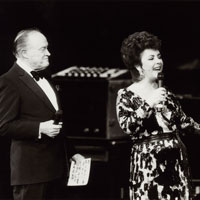 Nationally renowned venues like the Kennedy Center, as well as local community arts centers, hosted fundraising performances. TV and radio stations held telethons. And top artists donated their time for these events, including Bob Hope and Elizabeth Taylor, seen performing at a star-studded gala at DC’s Capital Centre.
Nationally renowned venues like the Kennedy Center, as well as local community arts centers, hosted fundraising performances. TV and radio stations held telethons. And top artists donated their time for these events, including Bob Hope and Elizabeth Taylor, seen performing at a star-studded gala at DC’s Capital Centre.
Well-wishers from all 50 states sent donations and heartfelt letters. They shared memories, such as getting engaged at Wolf Trap, bringing their kids to the Filene Center for the first time, and hosting birthdays and anniversaries on the lawn. They wanted Mrs. Shouse to know that her loss was theirs as well.
Perhaps most touching was the support from children, who sent letters in crayon with taped-on pennies and nickels.
“It’s really quite remarkable the way people are reacting,” said the now late Mrs. Shouse. “People feel that Wolf Trap belongs to them.”
The show must go on
While long-term plans to rebuild the Filene Center got underway, staff raced to mount a temporary structure to house the upcoming 77-performance season. Their charge was unprecedented: in 6 weeks, construct a performance space in a sloping meadow capable of housing 3 months of shows by world-class artists, including symphonies, ballets, R&B greats, full-scale musicals, and jazz, folk, and bluegrass legends.
Staff members were also faced with renegotiating more than 1,000 artist and production contracts. In a stunning show of support, nearly every artist agreed to perform in the makeshift venue, which had yet to even be erected.
“When I called Ella Fitzgerald and Oscar Peterson, their agents said ‘Hey, you got a platform, we’ll be there,’” said Wolf Trap’s then Director of Programming Ann Mckee. “Preservation Hall Jazz Band didn’t even wait for a call. They contacted Wolf Trap offering to add a second performance for free.”
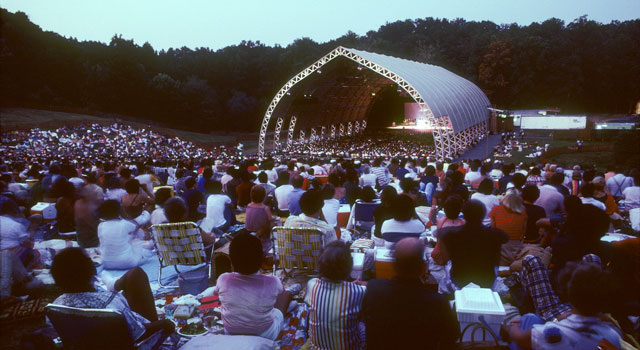
As artists stepped up to the cause, plans for the temporary structure—ultimately named the “Meadow Center”—got underway. While staff members were feeling a somewhat crazed version of “hey folks, let’s put on a backyard show!” they needed more than a tent and chairs. The search began for a structure that could hold a professional-scale stage, sophisticated sound, lighting, and production facilities, and 2,500 patrons under cover, while projecting each night’s spectacle to another 4,000 people on the lawn. Through Wolf Trap’s vast network, an appropriate structure was located in Dubai, of all places. As a show of good will toward Mrs. Shouse, and what they knew was an American cultural treasure, the Royal Saudi Arabian government covered the approximately $100,000 cost of shipping it to the United States.
While this was an important contribution, the new aluminum and vinyl structure was just the shell. What was created within and around this structure would not have been possible without hundreds of volunteers—primarily trade craftsmen in lighting, sound, wardrobe, stage design, and power—as well as a rapidly escalating number of community members who came out to help in any way possible as the deadline drew near.
These community volunteers set up thousands of folding chairs, sewed makeshift seat numbers, laid carpet remnants over gravel and mud backstage, helped turn construction trailers into dressing rooms and offices, nailed and carried and cleaned, and performed a number of other tasks in the spirit of ‘nothing’s too big or too small, we’ll be there!’
Richard Harrington from The Washington Post said the new Meadow Center looked like “a hybrid of a giant airplane hangar and a modernist Russian Orthodox Church.” Patrons were forgiving of the mud walkways and improvised layout. Artists graciously accepted modest trailers for dressing rooms and the gravel path to the stage. In the end, this one-of-a-kind performance space kept Wolf Trap’s spirit and service to the community intact for 2 full seasons, while the Filene Center was being rebuilt just a few hundred yards away.
The People’s Park Rises Again
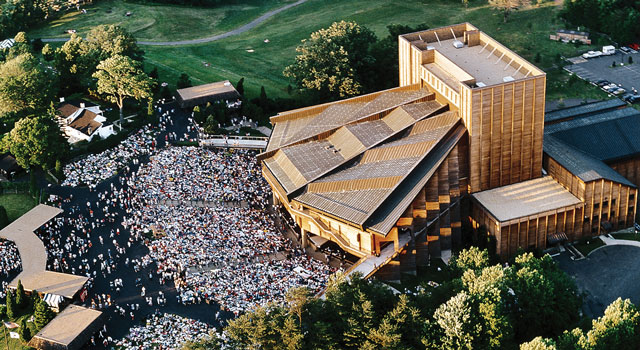
In 1984, just 1 year and 8 months after the fire, the new Filene Center opened to the public. Mrs. Shouse had wanted it to look the same as the old venue, which it did, while also providing significant improvements in safety, acoustics, backstage accommodations, and seating capacity. Patrons came in droves. They looked in awe at one of the country’s most beautiful outdoor arts venues restored and standing tall. The new Filene Center symbolized a world where the arts, and unique ways to experience the arts, are something to be protected and preserved.
Today, the community continues to demonstrate a sense of ownership and pride in the Filene Center. Support from patrons, donors, staff, volunteers, and artists ensures that Wolf Trap can overcome any challenge and remain a unique cultural treasure.